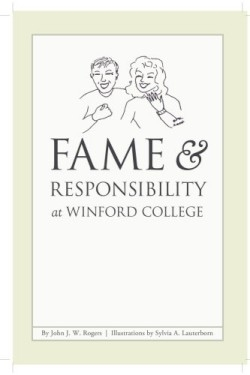Fame and Responsibility at Winford College
To be reminded that the qualities of precision and exactitude can also be funny is a little bit like being surprised that Albert Einstein had a wicked sense of humor. So if there is something a little cool, a little calibrated, about Rogers’ short novel—like its page one cast of characters (labeled as such) or its pithy “Interlude” pages covering years in the narrative in prim bullet points—the effect is unexpectedly and regularly amusing. It’s as if the author, who freely acknowledges in the very first words of his foreword that he was a geology professor for 50 years, took a couple of continuing education courses in writing fiction and all his received wisdom to heart. You’d think it would generate precise, exact prose, but this work is more than that, it is endearing.
Equally heartening is the story Rogers aims to tell. For Fame & Responsibility focuses less on what occurs to that cast of characters (each elegantly explored and described) than a celebration of the life of Winford College, a fictional and dysfunctional institution of higher learning in Kentucky, over the course of more than 100 years. From the imparted image of Winford as an architectural aberration to the simply priceless names of many characters (football coach “Mangler Bonemeal” is chuckle-out-loud worthy), the book is satire lovingly swaddled in affection.
Happily, there are also strong whiffs of realism, like the undergrad who cannot grasp nuance, drops out and goes on to distinguished government service, or the feisty college benefactor with a marked tendency toward potty mouth. There are funny bits to be expected: all the creative metaphors to describe the gripping horror of college food; all the allusions to the ways sex and dating have evolved across the generations. And there can be no surprise in curare-tipped jabs at the idiocies of college presidents that are removed, intellectually and emotionally, from the students they are paid to represent and serve. In essence, Rogers is taking kernels of truth—seared in his memory by a half-century of academic immersion—to their logical (often wacky) outcomes.
It can be challenging to follow all the major and minor stories plus the individuals. Not only will the list of characters likely need multiple consultations, but the idea of an index for this book doesn’t actually seem far-fetched. Rogers also tinkers with stylistic fillips and fragmenting narrative—one character dreams in personality-revealing inner monologues, several moments of action come to a halt in favor of rhyming couplets and bits of poetry—and these choices can sometimes impede the book’s progress. But, that the pupil has learned the formula is clear. And, that the pupil has applied it with such rigor and verve indicates that he may well be a future master of the art.
Reviewed by
Leonard Jacobs
Disclosure: This article is not an endorsement, but a review. The publisher of this book provided free copies of the book and paid a small fee to have their book reviewed by a professional reviewer. Foreword Reviews and Clarion Reviews make no guarantee that the publisher will receive a positive review. Foreword Magazine, Inc. is disclosing this in accordance with the Federal Trade Commission’s 16 CFR, Part 255.

